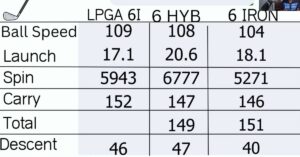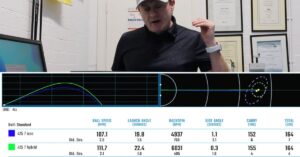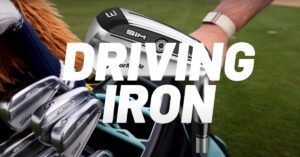What Club To Use At Driving Range? Finding The Right Fit
As a golfer aiming to improve skills, spending time at the driving range is essential. However, selecting the right club from the many options available can be challenging. Don’t worry; we have you covered.
When it comes to choosing the right club at the driving range, it’s essential to consider your goals for the session. If you’re looking to work on your swing, then a mid-iron or hybrid club might be the best choice. For accuracy improvement, go for a short iron or wedge.
In this blog post, we’ll provide you with expert tips and advice on what club to use at the driving range for maximum results.
Comparing Club Options: Irons, Woods, And Hybrids
When choosing the right golf clubs for your game, understanding the differences between irons, woods, and hybrids is crucial. Here’s a table comparing the characteristics of irons, woods, and hybrids for driving range use:
| Category | Irons | Woods | Hybrids |
| Purpose | Precision and control | Power and distance | Versatility and forgiveness |
| Clubhead | Smaller | Larger | Between irons and woods |
| Face | Thinner | Thicker | Varies |
| Shot Types | Fairway and approach | Tee and long approach | Various |
| Loft | Consistent | Varies | Varies |
| Spin | Consistent | Varies | Varies |
| Forgiveness | Moderate | Moderate to high | Moderate to high |
| Shot-shaping | Excellent | Limited | Varies |
| Suitable Skill Level | All levels | Experienced players | All levels |
Irons: Precision and Control
Irons are known for their precision and control, making them a popular choice for golfers who prioritize accuracy over distance.
These clubs feature smaller clubheads and thinner faces, allowing players to have better control over their shots. Irons are typically used for shots on the fairway and around the green, offering better maneuverability and accuracy for approach shots and chip shots.
One of the key advantages of irons is their ability to provide consistent loft and spin, which is crucial for distance control and accuracy.
They also offer better shot-shaping capabilities, allowing skilled players to manipulate the ball’s flight path as needed. However, irons may not provide the same distance as woods or hybrids, making them less suitable for long shots.
Woods: Power and Distance
Woods, on the other hand, are designed to maximize power and distance. These clubs have larger clubheads and longer shafts, enabling golfers to generate more clubhead speed and launch the ball further down the fairway.
Woods are commonly used for tee shots and long approach shots, where distance is of utmost importance.
The larger clubhead size of woods provides a larger sweet spot, increasing forgiveness on off-center hits. This can be beneficial for golfers who struggle with consistent ball striking.
However, woods can be more difficult to control compared to irons, especially for players who are still developing their swing technique. They may also have limited shot-shaping capabilities due to their design.
Hybrids: Versatility and Forgiveness
Hybrids, as the name suggests, are a combination of irons and woods, offering a balance between the two.
These clubs have a design that incorporates features from both irons and woods, making them versatile and forgiving. Hybrids are known for their ease of use, making them a popular choice for beginners and high-handicap players.
Hybrids typically have a larger clubhead compared to irons but smaller than woods, providing a larger sweet spot and improved forgiveness.
They are designed to be more forgiving on mishits, reducing the impact of off-center strikes. Hybrids are suitable for a variety of shots, from tee shots to fairway approaches and even shots from the rough.
Factors To Consider When Choosing A Club
When selecting a golf club for a driving range, there are several factors to consider to ensure an enjoyable and effective practice session. Here are some key aspects to keep in mind:
Club Type and Loft
The choice of club primarily depends on your personal preference and the specific goal of your practice session.
Drivers with higher lofts are suitable for beginners or those aiming for more height and control, while lower lofted drivers are better for experienced golfers seeking distance.
Club Length and Weight
Consider the length and weight of the club as they can significantly impact your swing mechanics and overall performance.
Longer clubs generally generate more power, but they might be more challenging to control. Experiment with different lengths and weights to find the right balance.
Shaft Flexibility
The flexibility of the club’s shaft determines the amount of bend it exhibits during the swing. The flex rating typically ranges from extra stiff to ladies’ flex, and your choice should align with your swing speed and tempo.
A slower swing speed benefits from a more flexible shaft, while a faster swing may require a stiffer one.
Grip Size and Material
A proper grip is crucial for comfort, control, and consistency during your swing. The size of the grip should fit comfortably in your hands, allowing for a relaxed yet firm hold.
Additionally, consider the material of the grip, as some may provide better traction and dampening for improved feel.
Budget and Quality
Take into account your budget and the quality of the club. While it’s tempting to opt for cheaper options, investing in a well-made club from reputable brands can enhance your practice experience and potentially improve your game.
Look for clubs that strike a balance between affordability and durability.
Try Before You Buy
Whenever possible, try out different clubs at the driving range or seek professional advice.
Testing clubs firsthand allows you to assess how they feel and perform in your hands, enabling you to make an informed decision based on your swing characteristics and preferences.
Tips For Selecting The Best Club For Your Practice Session
When it comes to selecting the best club for your practice session at the driving range, there are a few key factors to consider. By keeping these tips in mind, you can maximize your practice time and improve your golf skills.
Assess Your Skill Level and Goals
Begin by assessing your current skill level and setting specific goals for your practice session.
Are you a beginner looking to work on your swing technique or an experienced golfer aiming to refine your accuracy and distance? Identifying your skill level and goals will help you choose the appropriate club for your practice needs.
Consider the Club’s Loft
The loft of a club refers to the angle of the clubface, which affects the trajectory and distance of the ball.
For beginners or those focusing on consistency, clubs with higher lofts, such as irons or wedges, can be easier to hit and provide better control.
Advanced players may opt for lower lofted clubs, such as drivers or fairway woods, to work on maximizing distance.
Start with Mid-Iron Clubs
If you’re unsure which club to use, starting with mid-iron clubs like a 6- or 7-iron can be a good choice.
These clubs offer a balance of distance and control, making them versatile for various practice scenarios. They can help you work on your swing mechanics and develop a consistent ball flight.
Experiment with Different Clubs
While starting with a mid-iron is a good guideline, don’t be afraid to experiment with different clubs during your practice session.
Trying out different clubs can help you understand their unique characteristics and how they affect your shots.
This experimentation can be valuable for discovering which clubs work best for specific situations on the golf course.
Seek Professional Advice
If you’re still unsure about which club to use, consider seeking advice from a golf professional or instructor.
They can provide personalized guidance based on your skill level, swing mechanics, and goals. A professional’s expertise can help you make an informed decision and optimize your practice session.
Frequently Asked Questions
If you’re heading to the driving range to practice your golf swing, you may wonder which club to use. Selecting the right club can help you improve your game and get the most out of your practice sessions.
Here are some quick and clear frequently asked questions about what club to use at the driving range:
Can I Use My Hybrid Club At The Driving Range?
Absolutely! Hybrid clubs are versatile and can be useful for practicing different types of shots, including long approaches and tee shots on shorter par 3s.
Should I Bring My Putter To The Driving Range?
While the driving range focuses on full swings, it can be helpful to bring your putter to practice putting distance control and alignment on the practice green.
Can I Use A Specialty Club, Such As A Lob Wedge Or Sand Wedge?
Yes, using specialty clubs like lob wedges or sand wedges can help you refine specific shots and improve your short game skills.
Should I Vary The Clubs I Use At The Driving Range?
Yes, it’s beneficial to use different clubs to simulate various on-course situations and enhance your overall golf skills.
How Do I Decide Which Club To Use At The Driving Range?
Consider your practice goals, the shots you want to work on, and rotate through your clubs to get a well-rounded practice session.
Conclusion
Choosing the right club at the driving range is crucial for improving your golf skills. Consider your goals, skill level, and the specific characteristics of irons, woods, and hybrids.
Experiment with different clubs, seek professional advice, and focus on developing a consistent swing to maximize your practice session.






